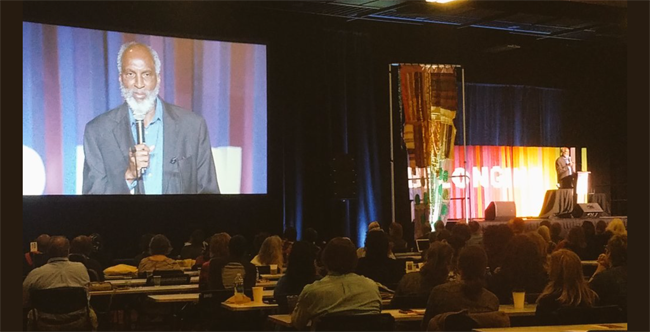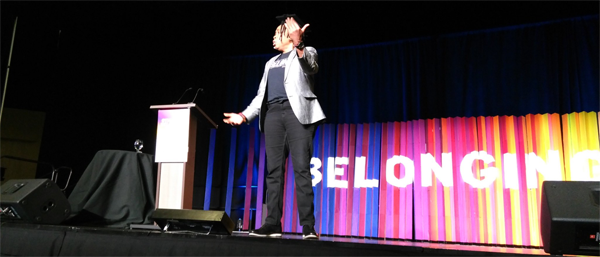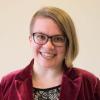
This April I had the opportunity to attend the Othering and Belonging 2019 Conference, hosted by the Haas Institute for a Fair and Inclusive Society at the University of California-Berkeley. The three-day, biennial conference focuses on what the Haas Institute’s mission to investigate social hierarchies based on power differentials and resource access (you can find more about the Haas Institute and the Othering and Belonging Journal here).
In a mix of keynote presentations, breakout sessions, and informal events, the conference programmers aimed to spark conversation about what it means to truly belong in a space, with examples such as college campuses, cities, and churches. It is a Herculean effort to engage 1500+ people from a range of backgrounds and disciplines in conversation about moving beyond diversity and inclusion, and engaging an audience including social justice-minded, research-based scholars and activists is especially daunting. Yet Othering and Belonging did just that, and brought together people from across the globe to have these conversations and explore belonging in their spaces.
Conference keynote and Haas Institute director john a. powell focused his talk on two contrasting visions for the world and the future: one of othering, which he operationally defines as “a hierarchical We” in which people base power on fear, control, and exploitation; versus one of belonging, which he operationally defines as “an expanding We” in which people share resources, access, and power with one another. Where a vision of othering is a “contracting We,” a vision of belonging expands the Circle of Human Concern to include all people of all identities (You can watch john a. powell’s full talk here, as well as many of the other conference keynote speeches).
|

john a. powell sets the tone for the conference as an Othering and Belonging 2019 Keynote. Credit: Haas Institute for a Fair and Inclusive Society. |
With this framing in mind, I couldn’t help but reflect on our own year of programming here at the CTL, and some of the ways we think about belonging and inclusion in our spaces. Besides our biannual Inclusive Teaching and Learning Symposia, which are explicitly focused on inclusion in UT classrooms and spaces, we are also continuously attempting to model spaces where attendees, be they faculty, graduate students, or staff, are not only given resources and learning opportunities but are also made to feel a part of our community of teachers and learners.
Recently, I’ve been inspired by Priya Parker’s The Art of Gathering to think critically about how we bring instructors together for CTL events. Parker’s excellent book provides a framework for creating gatherings of all kinds that are grounded in a core purpose and whose elements bolster and drive that purpose. A few of her points resonate with my work at the CTL and the work I experienced at Othering and Belonging, especially related to how we bring people together:
Commit to a bold, sharp purpose. Parker says that all gatherings should have a fundamental purpose (which is different from a category, such as “workshop” or “birthday party”). This purpose should be specific, unique, and disputable, and furthermore it should act as a lens through which all decisions about the gathering should be filtered. If some element does not further the purpose of the gathering, it has no place in the plans.
Othering and Belonging’s purpose is right in the title, and the purpose courses through the conference’s veins. The framework of othering and belonging permeated the conversations of the conference sessions and directly influenced the speakers, workshops, and activities happening at the conference.
Intentional exclusion makes space for those for whom the gathering serves. In order to activate diversity, ask “Who is this gathering for first?” and kindly exclude those who threaten the purpose of the event or do not fulfill that purpose. As Parker describes, “By closing the door you create the room.”
|

At the CTL's Graduate Teaching Showcase, graduate students and faculty benefit from discussing teaching together, which makes the event a perfect time to include both audiences. |
When creating CTL programming, we often have specific target audiences for our workshops and events. For example, many of our graduate student development programs are limited to participation from graduate students, in order for them to have space to ask questions that they may be uncomfortable voicing in front of their faculty. However, other events such as the Graduate Teaching Showcase and Eyes on Teaching greatly benefit from having graduate students and faculty interact with one another, so these events are open to both (not to mention staff and administration). We have seen that in some cases, limiting the audience by a particular parameter creates more learning opportunities for those we are aiming to serve in that particular event.
Create a temporary alternative world within every gathering. Explicit pop-up rules, such as community agreements, create conditions in which everyone in the room knows what to expect and understands what they are responsible for; unlike unspoken traditions such as “conference etiquette,” which is inherently culturally biased, explicit agreements and rules put everyone on the same page.
At the CTL we have begun implementing a few pop-up rules in some of our events, such as including pronouns on nametags and having community agreements at the beginning of workshops. In creating these temporary, explicit rules, we are both aiming to acclimate participants with our expectations during the event, and also model some explicit expectations instructors can use in their teaching as well.
Design realness in a gathering so attendees do not have to flounder for applications and connections themselves. Encourage attendees to bring to the table what Parker calls their “half-baked parts,” where learning and growth are most likely to happen.
|

Conference presenter and vocal activist Melanie DeMore brings the attendees together in song and challenges them to use art and song to foster belonging. Credit: Haas Institute for a Fair and Inclusive Society. |
This was definitely an ongoing thread at Othering and Belonging, where everyone from Mainstage Keynotes to high school-aged participants were welcome to give input and ask difficult questions, whether or not they knew the answers.
The CTL has never hosted a 1500-person conference on Belonging, but we do continuously refine what we do to include more diverse voices on campus and improve teaching and learning for broader audiences, including those outside of the classroom. It was exciting to see how UC Berkeley is having these conversations and asking these questions, and showed us at the CTL a few ways we can continue our own efforts to make instructors and students find belonging at UT.

Sarah Schoonhoven (Associate Project Manager, Center for Teaching and Learning), Sarah works to create programming for instructors at the faculty, staff, and graduate student level in the UT Center for Teaching and Learning and strives to center the full, radical inclusion of LGBTQA+ students and instructors in her work.

